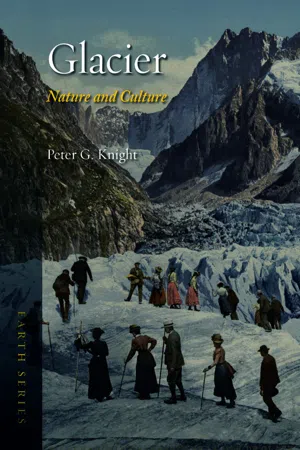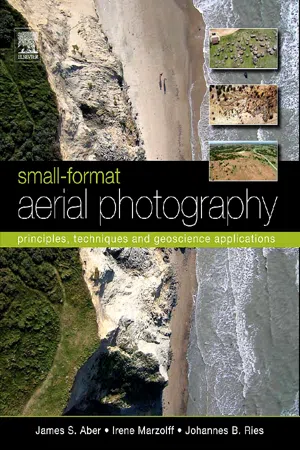Glacial Movement
Glacial movement refers to the slow flow of ice within a glacier. This movement is driven by the force of gravity and the internal deformation of the ice. Glaciers can move in various ways, including sliding along their base and flowing like a viscous fluid. The study of glacial movement is important for understanding how glaciers shape the landscape and contribute to processes like erosion and deposition.
4 Key excerpts on "Glacial Movement"
- eBook - ePub
Glacier
Nature and Culture
- Peter G. Knight(Author)
- 2019(Publication Date)
- Reaktion Books(Publisher)
...This mechanism of glacier motion and till formation was not mentioned in 1895 because at that time nobody knew that glaciers moved in that way. This idea did not emerge until the 1970s, and was heralded as a paradigm shift in glaciology. Glaciologists previously assumed that glaciers moved by sliding across the ground underneath them or by deforming internally. Once it had been suggested, it seemed obvious that large areas of present and former ice sheets rested not on rigid bedrock but on soft sediments. In the decades that followed, the idea of subglacial deformation was applied to the solution of several major glaciological and geomorphological problems, including the mechanisms behind the extraordinary fast flow of ice streams, the explanation of periodic ice-sheet surges, and the origin of that most enigmatic of landforms, the drumlin. A glacially striated erratic emerging from the till cliff at Thurstaston, Wirral, indicating the provenance of the till and hence the direction of flow of the ice that deposited it. So, while many of the basics of glacier science were established by the start of the twentieth century, that century saw more than a simple consolidation of knowledge; it witnessed some substantial technological, theoretical and practical advances. But as that century closed, there were still big issues or ‘grand challenges’ facing the discipline. Big issues for the twenty-first century Glacier scientists have some clear points of focus in the early twenty-first century...
- eBook - ePub
Small-Format Aerial Photography
Principles, Techniques and Geoscience Applications
- James S. Aber, Irene Marzolff, Johannes Ries(Authors)
- 2010(Publication Date)
- Elsevier Science(Publisher)
...Chapter 12 Glacial Geomorphology 12.1. INTRODUCTION Modern glaciers and ice sheets cover approximately 10% of the world’s land area. Of this, most glacier ice is found in Antarctica and Greenland with all other areas accounting for only about 5% of the total. During the Ice Age (Pleistocene Epoch) of the last one million years, glaciers and ice sheets expanded dramatically and repeatedly over large portions of northern Eurasian and North American lowlands and in mountains and high plateaus around the world. At times, the volume of glacier ice during the Pleistocene was at least triple that of today (Hughes et al., 1981). Global sea level declined by at least 120 m, which allowed ice sheets to spread over broad continental shelves, particularly north of Eurasia (Svendsen et al., 1999; Polyak et al., 2000). Geomorphology is the study of the Earth’s surficial landforms both on land and on the seafloor. This study is both descriptive and quantitative; it deals with morphology, processes, and origins of landforms. Glacier ice is a powerful agent that created many distinctive landforms that are well preserved nowadays in regions of former ice expansion. Glaciers modify the landscape in three fundamental ways by erosion, deposition, or deformation (Fig. 12-1). A given site may be subjected to each or all of these processes during the advance and retreat of a glacier, and repeated glaciation may overprint newer landforms on older ones. In addition, glacial meltwater is also an effective geomorphic agent that may erode or deposit conspicuous landforms in connection with glaciation. The results are complex landform assemblages that represent multiple glaciations during the Pleistocene. Aerial photography has long been utilized to illustrate, describe, interpret, and map the diverse types of landforms created by glaciation (e.g. Gravenor et al., 1960)...
- eBook - ePub
- Charles H. Smith, James T. Costa, David A. Collard(Authors)
- 2019(Publication Date)
- University of Chicago Press(Publisher)
...This is founded on their surface and bottom contours, both of which are shown to be such as would necessarily arise from ice action, while they would not arise from the other alleged mode of origin—unequal elevation or subsidence.” 31 Years earlier Wallace had been embroiled in a discussion concerning the way glaciers move. Glaciologist Doug Benn has very nicely summarized one part of the question in a commentary he provided some years ago on a short Wallace article, “The Theory of Glacial Motion”: The debate on the causes of glacier motion lasted for many years during the 19th Century. Major sticking points were (1) the fact that ice appears to be a rigid, brittle material, yet the large-scale motion of glaciers requires that the ice flows as a continuous mass; and (2) a mass under a constant force (gravity) should be expected to accelerate downhill (as all falling objects do) whereas glaciers exhibit periodic, often annual, fluctuations in speed. Wallace’s note . .. correctly dismisses some of the fallacies current at the time, giving reasons why ice motion cannot be due to freeze-thaw action or “molecular adjustment.” His own preferred mechanism, of localised fracture and regelation (healing of fractures by refreezing) is closer to the mark, but still not complete. . . . Where Wallace does hit true, however, is his recognition of basal sliding as the main mechanism by which Alpine glaciers move. His comments that meltwater reaching the bed will encourage motion by “melting away its lower surface, and . .. to some extent, buoying it up” 32 are exactly correct. This is indeed the reason why Alpine glaciers flow more rapidly during the day and in summer, when meltwater fluxes are highest...
- eBook - ePub
Hydrogeology
Principles and Practice
- Kevin M. Hiscock, Victor F. Bense(Authors)
- 2021(Publication Date)
- Wiley-Blackwell(Publisher)
...3 Groundwater and geological processes 3.1 Introduction This chapter discusses the response of groundwater systems to geological processes such as plate tectonics, glaciation and sea‐level fluctuations. Although topography‐driven groundwater flow, as introduced in Chapter 2, is in many areas of the world the dominant mode of groundwater circulation, consideration of the additional impact of geological processes on groundwater flow is often important to fully appreciate the dynamics of groundwater systems on relatively long timescales (millennia). For example, only by considering the hydrogeological impacts of glaciation and associated sea‐level low stand, can the occurrence of fresh water underneath the sea‐floor along much of the continental shelf be understood. In the description of regional groundwater flow systems, which typically reach circulation depths of several kilometres, flow driven by the variable density of groundwater and flow induced by stresses imposed on pore fluids play an important role and often form the sole driver of fluid flow in the absence of topographically driven flow. The variable density of groundwater and anomalous pore pressures can be caused by a suite of geological processes. Thus, to understand fluid flow patterns in relatively deep hydrogeological systems requires an understanding of how the relevant geological processes cause fluid flow. It is the task of the hydrogeologist to evaluate, for a given geological setting, which processes can be expected to be dominant in driving fluid flow in the subsurface. The way groundwater and other geofluids, such as hydrocarbons, respond to geological forcing often has a direct feedback on how geological processes proceed. This feedback mechanism is, for example, important when the influence of fluids on seismicity should be considered...



